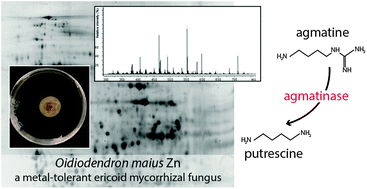Common and metal-specific proteomic responses to cadmium and zinc in the metal tolerant ericoid mycorrhizal fungus Oidiodendron maius Zn†
Abstract
Although adaptive metal tolerance may arise in fungal populations in polluted soils, the mechanisms underlying metal-specific tolerance are poorly understood. Comparative proteomics is a powerful tool to identify variation in protein profiles caused by changing environmental conditions, and was used to investigate protein accumulation in a metal tolerant isolate of the ericoid mycorrhizal fungus Oidiodendron maius exposed to zinc and cadmium. Two-dimensional gel electrophoresis and shotgun proteomics followed by mass spectrometry lead to the identification of common and metal-specific proteins and pathways. Proteins selectively induced by cadmium exposure were molecular chaperons of the Hsp90 family, cytoskeletal proteins and components of the translation machinery. Zinc significantly up-regulated metabolic pathways related to energy production and carbohydrates metabolism, likely mirroring zinc adaptation of this fungal isolate. Common proteins induced by the two metal ions were the antioxidant enzyme Cu/Zn superoxide dismutase and ubiquitin. In mycelia exposed to zinc and cadmium, both proteomic techniques also identified agmatinase, an enzyme involved in polyamine biosynthesis. This novel finding suggests that, like plants, polyamines may have important functions in response to abiotic environmental stress in fungi. Genetic evidence also suggests that the biosynthesis of polyamines via an alternative metabolic pathway may be widespread in fungi.

- This article is part of the themed collection: Zinc in the Biosciences

 Please wait while we load your content...
Please wait while we load your content...